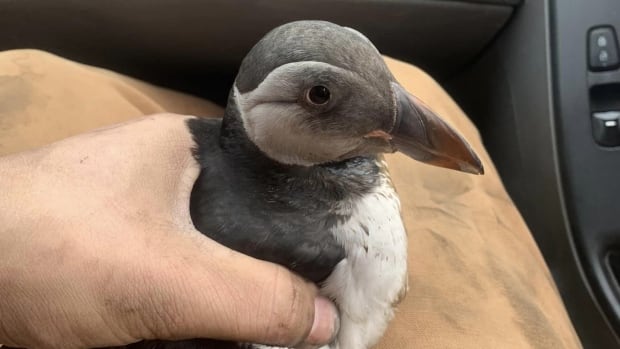An Atlantic puffin found itself in a bit of a bind after wandering onto a busy New Brunswick road, far from where the seabirds are supposed to be found this time of year.
David Gordon came across the puffin flapping around on the busy Coverdale Road in Riverview, near the Gunningsville Bridge, Thursday afternoon.
“My wife was like, ‘That looks like a penguin,'” said Gordon, who darted out into traffic to rescue the bird after he and two other drivers swerved around it.
Gordon says he scooped up the puffin as it was flapping around and brought it into his car as it was clearly dazed.
“But there was no blood, no visible injuries that I could see,” said Gordon.
Wary of the avian flu that’s affecting some birds in the region Gordon said he and his wife changed their plans and decided to make a beeline for the nearest veterinarian. The bird sat in his lap, occasionally nipping at him, for the five-minute drive.
“Just little pecks, they didn’t hurt,” said Gordon. “He was looking out the window — almost like taking my cats for a drive.”
He says he had no clue he was holding a puffin as he’d never seen one before.
They dropped the bird at the Riverview Animal Hospital where it was then taken to the Atlantic Wildlife Institute near Sackville.
“It’s definitely an unusual occurrence to find an Atlantic puffin this far inland,” said Pam Novak, the wildlife care director at the institute.
Normally found in the Atlantic ocean, this surprised passerby scooped up the seabird.
Novak said when they first got an email about a wayward puffin, she thought it was an auto-correct error and that they were discussing a pigeon. She calls this puffin a “rarity’ and a “mystery bird.”
“We have gotten, probably over the 27 years we have been here, not even a handful,” said Novak.
Atlantic puffins are normally found in New Brunswick on the isolated Machias Seal Island in the Bay of Fundy. They breed there for a few months in the summer before heading out into the open Atlantic where they spend their winters.
To find an Atlantic puffin this far inland, especially in winter, is head scratching.

“It’s odd, and I’ve been checking to see what other records there are, and there doesn’t seem to be too many of finding them inland this time of year in late winter,” said Novak.
As puffins are very social birds that live in colonies, Novak says she has been holding her breath waiting for more phone calls of lost puffins, perhaps indicating that a flock was blown off course from the ocean, but so far, it’s only the single bird that’s been called in.
The little puffin is, so far, in pretty good shape. Novak says it tends to look a little more drab than people might expect, but that’s normal for this time of year. Their signature candy-corn-coloured beak brightens during mating and breeding season and becomes muted during the winter months.
She’s not sure of the sex of the bird, but its wings and legs are fine and there don’t seem to be any injuries from landing on the pavement. It’s not malnourished and stands a good chance of being released back into the wild if it doesn’t show any signs of hidden injuries in the days ahead.
“He’s seemingly okay, so hopefully we can give him a clean bill of health soon,” said Novak.
They’ll release the little puffin by open ocean water, she said, ideally within a straight shot of Machias Seal Island, where it can hopefully find its way back to its colony.



